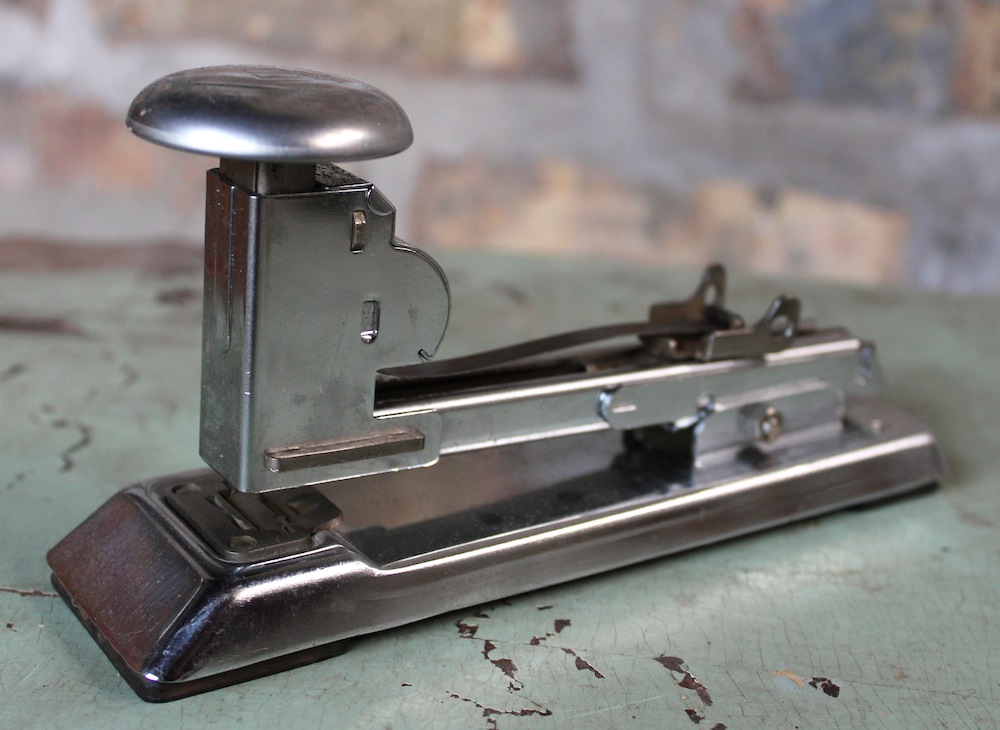
Museum Artifact: Ace Pilot Stapler 404, c. 1960s
Made by: Ace Fastener Corp., 3415 N. Ashland Ave., Chicago, IL [Lakeview]
Adapted from a patent application first filed back in 1930, the Ace Pilot stapler is a fine example of a simple, utilitarian design that’s gradually earned itself more of a retro, decorative appeal.
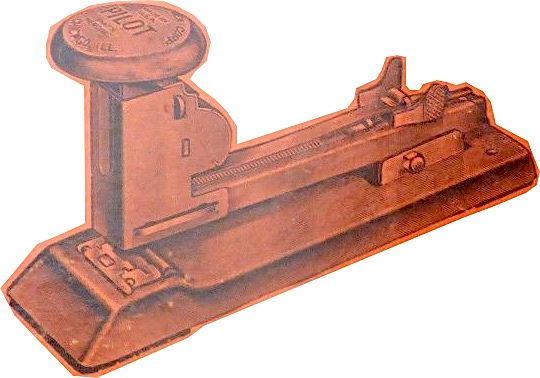 The early models were so pitch perfect in function, in fact, that subtle changes over the ensuing decades are barely detectable, making it mighty challenging to try and pinpoint the age of one Ace Pilot vs. another. The artifact in our museum collection, a Pilot 404, features the same steel construction, triple-plate finish, and big distinctive plunger handle as the older 402 model, but with an extra feature that allowed the user to detach the top section for use as a tacker. We can estimate its manufacturing date to the early 1960s for a few reasons, as brought to our attention by collector Frank Parsons over at the American Stationer blog:
The early models were so pitch perfect in function, in fact, that subtle changes over the ensuing decades are barely detectable, making it mighty challenging to try and pinpoint the age of one Ace Pilot vs. another. The artifact in our museum collection, a Pilot 404, features the same steel construction, triple-plate finish, and big distinctive plunger handle as the older 402 model, but with an extra feature that allowed the user to detach the top section for use as a tacker. We can estimate its manufacturing date to the early 1960s for a few reasons, as brought to our attention by collector Frank Parsons over at the American Stationer blog:
- Advertisements for the Pilot 404 can be found from 1959 onwards.
- The front portion of the Pilot’s base was blank until 1966, when the word ACE was added [our’s is still blank].
- The top of the plunger handle handle read “Ace Fastener Corp.” until 1968, when it switched to “Ace Fastener Co.” [our’s says “Corp”]
As late as the 1980s, the Ace Fastener Company (by then owned by the New York banking firm Dominick and Dominick) was still based in Chicago and still producing many of its famous brands—including the Pilot, Clipper, Aceliner, and Concorde—the same way it had for half a century.

“The Ace Pilot is the stapler that established Ace Fastener Company’s reputation for High Quality Office Products,” read a 1984 advertisement. “Pilots put on the job over 50 years ago are still performing flawlessly. This timeless design features heavy gauge all steel construction for the maximum service life in a desk top stapler. Clean functional lines are accentuated with durable chrome plating and non-skid rubber pads protect your work surfaces. The Ace Pilot has a stapling reach of 3-3/8″ and a magazine load of 210 Pilot Standard Staples. For lasting beauty and time proven performance, choose a classic—THE ACE PILOT STAPLER.”
Based on comments from visitors to the museum, many of those old vintage Pilots are STILL getting the job done even 30+ years after that advertisement ran. It’s a rare circumstance in the ever-changing world of office supplies for a single product to remain relevant for this long, particularly with no major mechanical or technological upgrades along the way. But by some magical confluence of genius and restraint, William Frederick Weber—inventor of the first Ace staplers—basically got it right the first time.
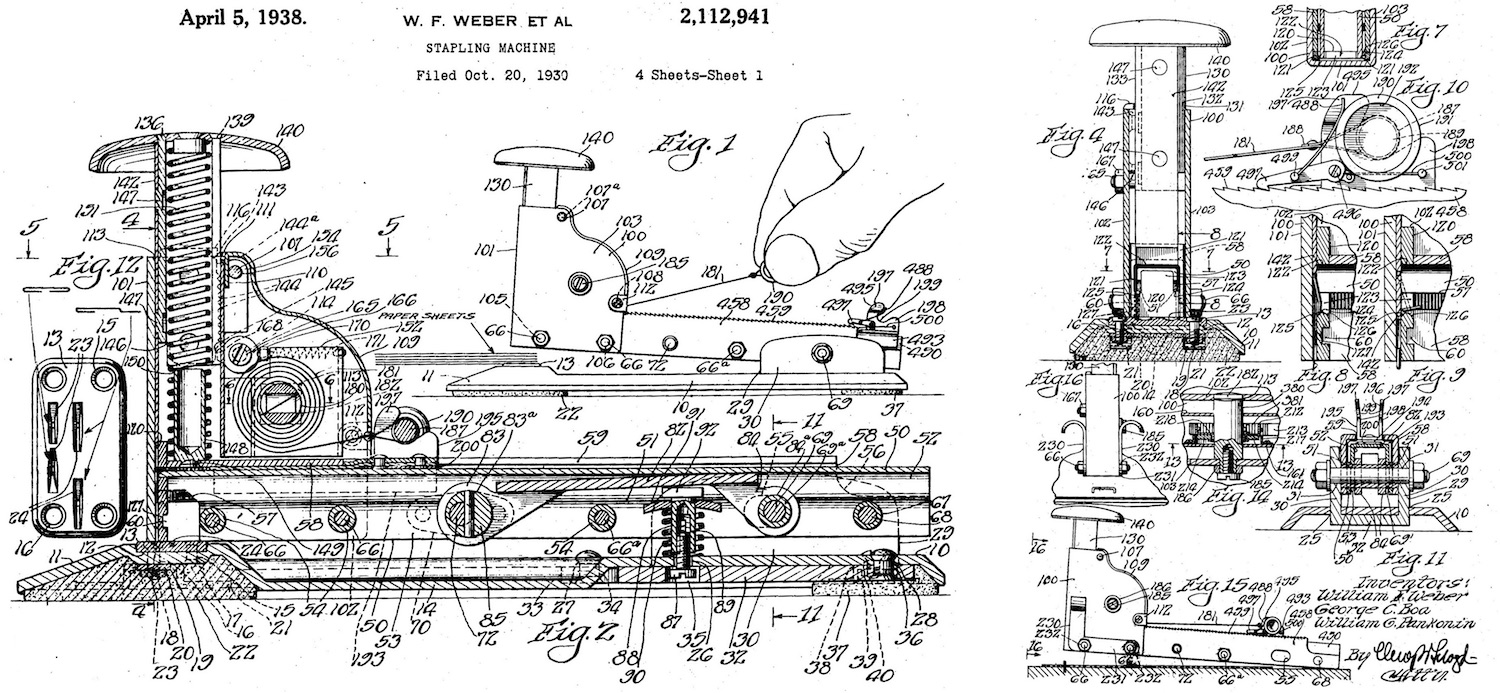 [Patent drawing for the original Ace Pilot Stapler, approved in 1938, and invented by Ace vice president William F. Weber, along with George C. Boa and William G. Pankonin]
[Patent drawing for the original Ace Pilot Stapler, approved in 1938, and invented by Ace vice president William F. Weber, along with George C. Boa and William G. Pankonin]
History of the Ace Fastener Corp., Part I: Webs and Triangles
Sadly, there’s not a great deal of surviving info out there about William Weber’s road to glory. Despite his major contributions to the world of office supplies, his own origins and those of the company he helped organize are shrouded in some mystery (the same goes for the current incarnation of the Ace brand, as you will soon find out). We do know that William was born in Indiana in 1882, and that he came to Chicago for manufacturing work as a youngster. In 1910, he and his wife Angie were living in an apartment in Lake View; she was a seamstress and he was an assembler for an adding machine company. By 1918, being a tad too old for military conscription, Weber helped the war effort by building aircraft parts in the tool factory of the Duro Metal Products Company. Presumably, by the 1920s, he’d begun experimenting with his own mechanical designs, but it’s not until 1930—perhaps forced by economic necessity—that William finally applied for his first patent on a “stapling machine.”
“The object of the invention,” he wrote at the time, “is to provide a novel stapling machine of the small hand-operated desk type, which is inexpensive to manufacture, is light and easy to handle, and will not jam, even when roughly or improperly used.”
As best we can tell, the actual business of making this novel stapler came about through an evolving partnership between Weber and an established Chicago firm known as the Triangle Tool & Manufacturing Co., which already ran a factory at 3415 North Ashland Ave.
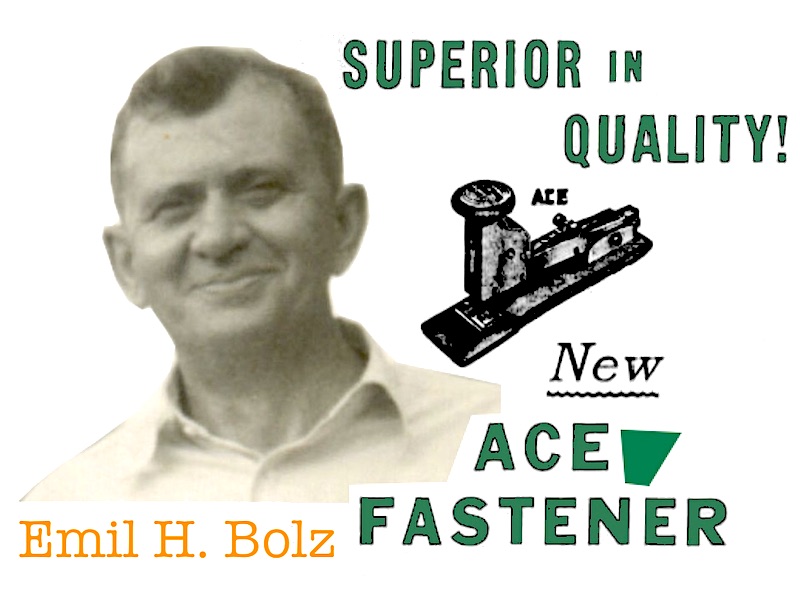 Triangle’s president, Emil H. Bolz (b. 1884), was a master mechanic himself, and likely agreed to invest in Weber’s inventions at the outset of the Depression, including a commitment to produce them inside his Ashland plant. Together with treasurer and fellow inventor William G. Pankonin, Bolz and Weber formed a new, separate corporation called the Ace Fastener Corp., which continued to operate under the same roof as the Triangle Tool & MFG Co. well into the 1950s.
Triangle’s president, Emil H. Bolz (b. 1884), was a master mechanic himself, and likely agreed to invest in Weber’s inventions at the outset of the Depression, including a commitment to produce them inside his Ashland plant. Together with treasurer and fellow inventor William G. Pankonin, Bolz and Weber formed a new, separate corporation called the Ace Fastener Corp., which continued to operate under the same roof as the Triangle Tool & MFG Co. well into the 1950s.
In 1938, when the Pilot stapler model was patented, William Weber was already 56 years old and serving as vice president and sales manager of the Ace Fastener Corp.; his salary, in the middle of the Depression, was a healthy $30K . . . about $550,000 after inflation. He had a handful of other stapler patents to his credit by this point, and was now seemingly focused on refining his original vision and ramping up national distribution. Business was good, simply put, because the stapling was better.
“An indispensable accessory to every modern business office,” exclaimed an ad for a regional office supply dealer in Chattanooga, Tennessee. “The Ace paper fastener operates in the twinkling of an eye, automatically clinching together sheets of paper with a secure, neat metal clasp. The machine is small and compact, with few parts, and the expense of operation is negligible. An Ace fastener will more than pay for itself in the insurance against the loss of important papers.”
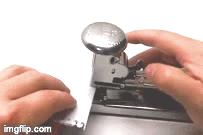 The lasting appeal of the Ace Pilot, specifically, comes down to a couple key breakthroughs and benefits. For one thing, it marked a considerable upgrade in functionality. It rarely jammed, and it included an innovative two-position anvil—meaning you could put it one position to staple something together, or shift to the other position to create a temporary hold, pin-style, that could be removed. Beyond that, there was that big shiny knob on top, just asking to be pressed. Generations of office workers took pleasure aggressively connecting stacks of paper with a gavel like slam of the palm. The side effect for the overly enthusiastic bookkeeper, unfortunately, was a bruised paw, which in turn led to the development (and eventual proliferation) of stapler designs with levers instead of knobs.
The lasting appeal of the Ace Pilot, specifically, comes down to a couple key breakthroughs and benefits. For one thing, it marked a considerable upgrade in functionality. It rarely jammed, and it included an innovative two-position anvil—meaning you could put it one position to staple something together, or shift to the other position to create a temporary hold, pin-style, that could be removed. Beyond that, there was that big shiny knob on top, just asking to be pressed. Generations of office workers took pleasure aggressively connecting stacks of paper with a gavel like slam of the palm. The side effect for the overly enthusiastic bookkeeper, unfortunately, was a bruised paw, which in turn led to the development (and eventual proliferation) of stapler designs with levers instead of knobs.
The typical looking Pilot stapler in our collection was probably manufactured at 3415 N. Ashland Avenue, which was Ace’s main plant from about 1930 to 1960. This factory not only rolled out the full line of commercial Ace staplers, but also became a top supplier of staplers and other goods to the government during World War II (due to metal rationing, “Victory” staplers from this period had distinctive wood bases). That old Ashland building is seen below, in its more recent role as the home of the Marvel Electric Co. It’s still standing, but at last check, was up for potential demolition and re-zoning as of 2020.
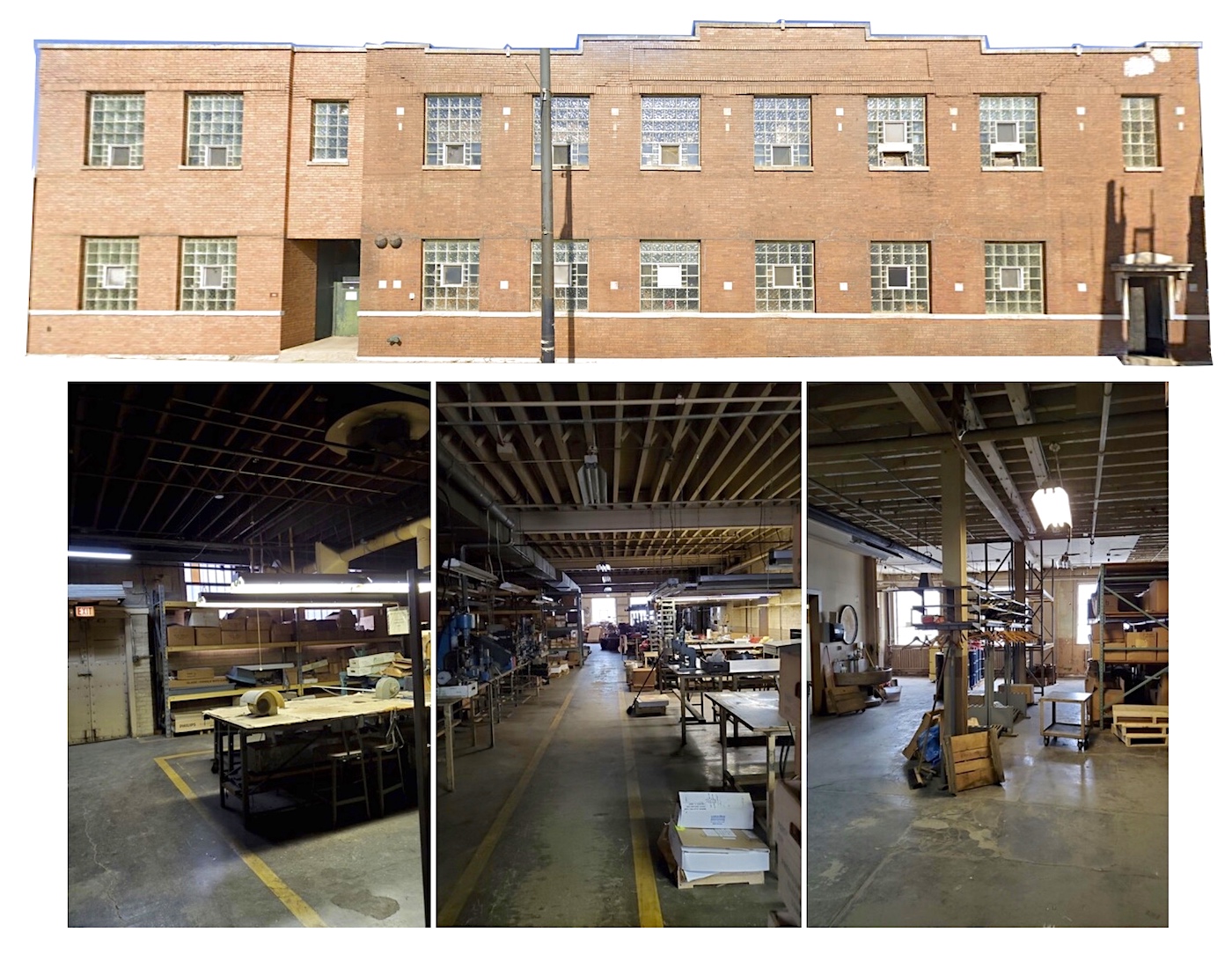 [Former Ace Fastener headquarters at 3415 N Ashland Ave.]
[Former Ace Fastener headquarters at 3415 N Ashland Ave.]
II. Ace In the Hole
Sadly, William F. Weber didn’t make it through the war himself. He died of a heart attack in his Evanston home at the age of 60 in 1942, leaving an aging E. H. Bolz in charge of the business going forward.
In 1953, Ace Fastener employed 250 people at the Ashland plant, and business was steady. Just four years later, though, the decision was made to sell controlling interest in the company to another well-known heavyweight of the paper fastening biz, Swingline (of New York). The deal turned Ace Fastener into a diminished Swingline subsidiary, but it did at least keep the Chicago offices open a while longer.
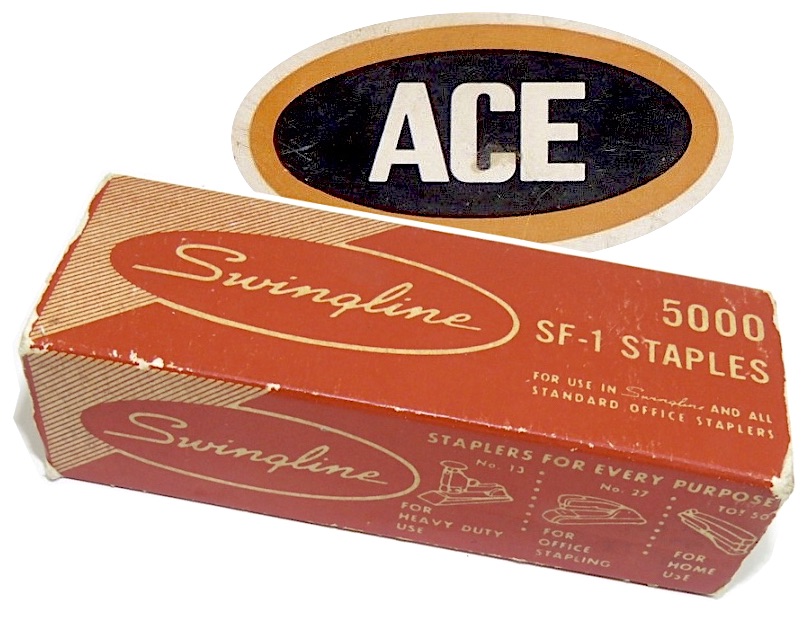 The Ashland Avenue plant was abandoned in 1960 and swapped for a new building at 4100 W. Victoria St. in North Park (which is also still in use today by a food services business), but stability in the 1960s was far from assured.
The Ashland Avenue plant was abandoned in 1960 and swapped for a new building at 4100 W. Victoria St. in North Park (which is also still in use today by a food services business), but stability in the 1960s was far from assured.
In 1966, Swingline purchased another staple of the stapling industry—Spotnails, Inc. of Rolling Meadows, Illinois—and essentially combined its business with Ace Fastener, installing Ace’s V.P. and general manager Walter M. Fisher in the same role with both firms. Just a few years later, Swingline itself was acquired by the mega-conglomerate American Brands, which eventually sold off both Ace Fastener and Spotnails company to the aforementioned banking firm of Dominick and Dominick in 1983.
Ace continued to make staplers into the 1990s, moving its home base into the Spotnails facility in Rolling Meadows. Tracking things from that point forward, however, leads us into some murky waters.
For one thing, if you google “ace fastener” these days, you’ll likely come to the corporate site of “Ace Fastener & MFG, Inc.,” a similar but mostly unrelated business based out of Camden, New Jersey. As a representative from the company recently informed us, “We are not affiliated with Ace Staplers, although we have sold them over the years. . . . I believe Spotnails bought out that Ace stapler line from the original manufacturer. As far as we know, the only stapler that is still being manufactured is the 702, and the only staples that are available are the 70001 and the 74001.”
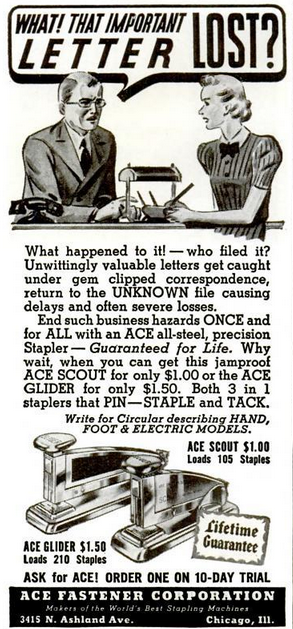 A visitor to the Made In Chicago Museum, by the name of Jeff, offered us a few additional corroborating details:
A visitor to the Made In Chicago Museum, by the name of Jeff, offered us a few additional corroborating details:
“I was talking to the company Spotnails in Chicago the other week about getting some staples manufactured for my company, and I found out some interesting information about the 1950s Pilot stapler in your write-up as well as who owns Ace Fasteners,” Jeff explained. “Spotnails (1100 Hicks Rd., Rolling Meadows, IL) apparently bought out Ace Fastener and the rights to its designs. A manufacturer named Peace Industries from Korea owns Spotnails and Ace as subsidiaries, I think. After the guy at Spotnails told me that information, I went to USPTO.gov and checked the trademark registration (for the Pilot brand) just to be sure. Sure enough, the guy was telling the truth about acquiring Ace Fasteners.”
Yes, indeed, if you follow the long paper trail of 15 owners of the “Pilot” patent since its initial registration in 1934, Peace Industries is the current holder, with the last renewal in 2007. There was also a litigation suit over some related patents that Peace settled for just $7,500 in 2014.
Our insider Jeff adds: “It seems as if the Pilot staplers and other Pilot branded products are manufactured and sold in Mexico on a pretty large scale. I don’t think they are exporting too much of it into the U.S. Not real sure.”
Peace Industries does own locations in Mexico, too, which might explain this Spanish language AceGrapasFifa website, featuring various old Ace products.
My what a long strange road it’s been since those simpler days of the 1930s, when the world was a John Steinbeck novel and the stapler you bought just might be the last you’d ever need.
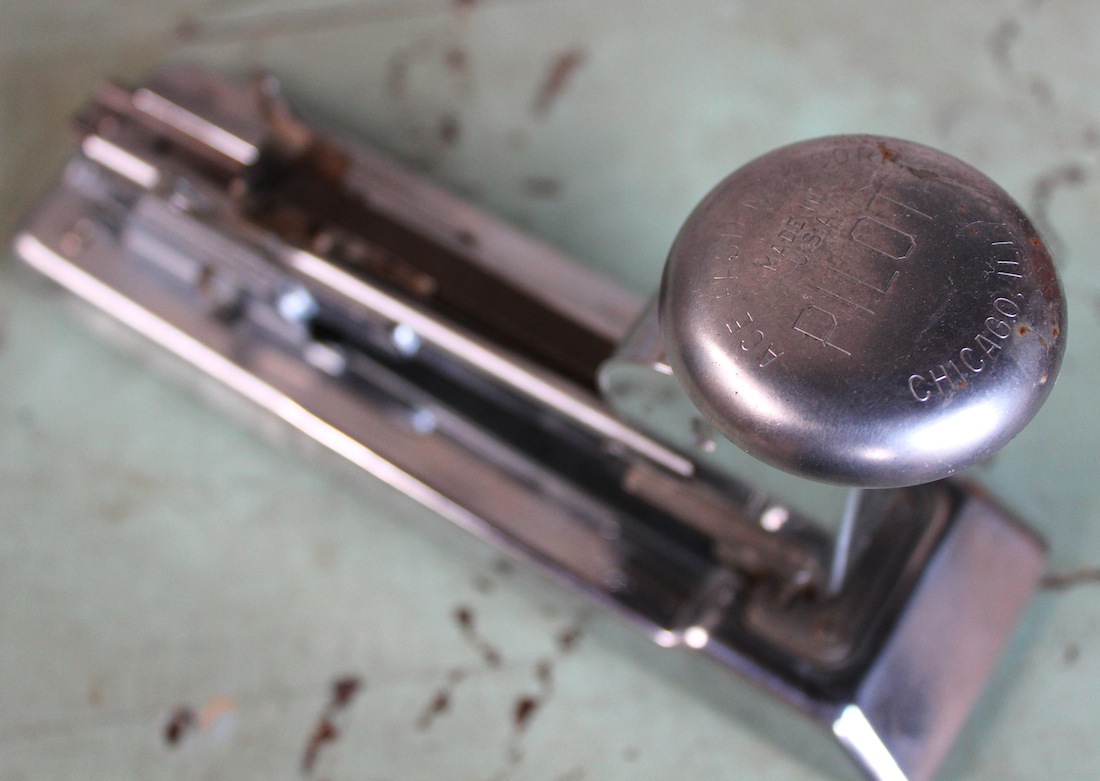
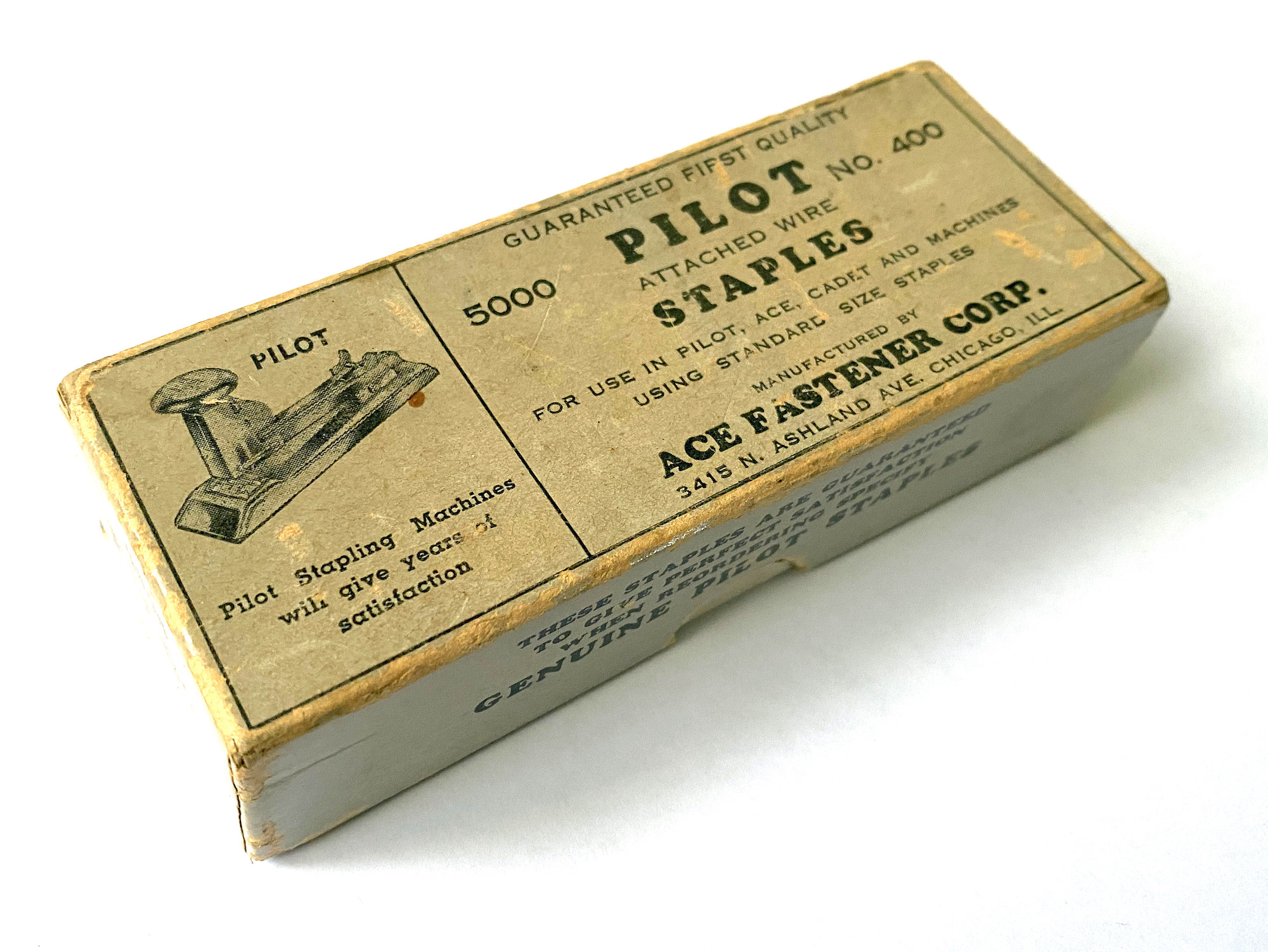
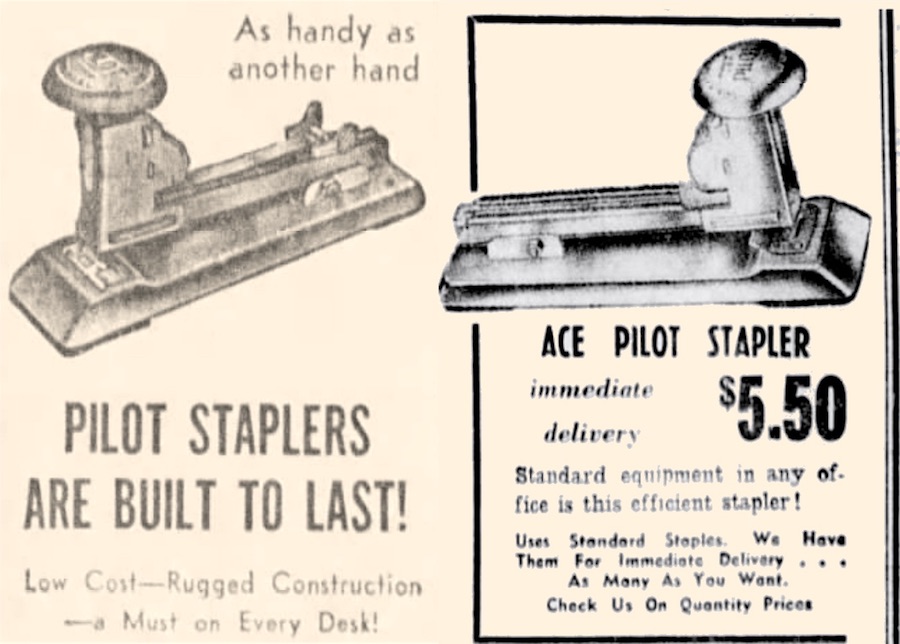
Sources:
“Spotnails Part of American Brands Sale of Ace Fasteners” – Fastener Industry News, 1983
“William F. Weber” (Obit) – Chicago Tribune, June 30, 1942
“Ace Fastener Corp.” – Chicago Tribune, Jan 12, 1937
Office Management and Equipment, Vol. 10, 1949
Lodging Hospitality, Vol. 40, 1984
The Rotarian, April 1941
Archived Reader Comments:

 “
“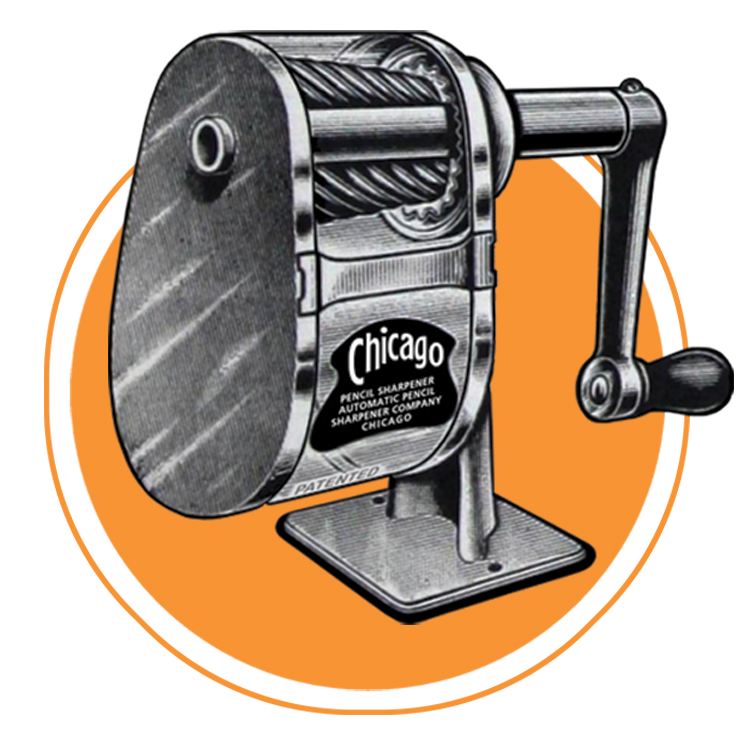
I was wondering where I can get some staples for my 302 cadet. Can’t seem to find them anywhere. I need number 300 staples.
I too have my dad’s Ace Cadet 302 still working in good condition with what appears to be a bakelite top.
I believe it is at least 80 years old.
Does it have any value?
I have several Scout 404 staplers from my mom and dad probably purchased in the early 60s, both in perfect working condition. It’s a shame products aren’t made like this anymore. I recently came across the smaller Scout 202 mode stapler at a yard sale for $1.00 but I need staples. Does anyone have any idea where I could get some? Please – any help would be appreciated!
I have a cadet 302 is it worth anything.
I worked there in the early 70s on a punch press. Made stapler and staple remover parts.
Good afternoon. I was looking at my old stapler and wondering if you could date what year it might have been made. I remember it being used by my dad when I was very young, in the early 1950’s but I think that had acquired before then. It has PILOT Model 402-D Use only PILOT 400 staples embossed on the steel spring steel staple retaining cover. I do not see a date of manufacture or other mark on it . The top plunger is embossed PILOT in the center and Ace Fastener Corp. Across the top and Chicago, ILL at the bottom. I also has MADE IN USA. On the top.
pLEASE COULD YOU REPAIR MY ACE FASTENER PILOT CHICAGO?
I have a Pilot 402 stapler that my father purchased (used, I think) in the early 1950’s.
Still works great.
Thanks for all the good information on the ace pilot brands. I have an ace pilot model 412 deep throat stapler made for stapling magazines or pamphlets. I just pulled the staples out of my swing line model 99 hand, plier stapler, and put them in the Ace pilot 412 and they work perfect. I have found that I should never buy staples that are not marked “premium” . The cheap ones jam and bend wrong.
i have in my possession a Pilot 402 Stapler, not exactly what year,it was my Father-in-laws, and i was wondering what the value of this item is.the last patent # is 2112941, if this helps in determing the value. Thank you.
I have boxes of ace staples 70008
Says they fit the clipper….bought a clipper 70020 . Wont fit ????
I have an Ace- scout from the 60s
I have a Ace stapler #502 that uses staples # 2025 or any staple that will fit for use. It has been the best stapler i have used for years. Where can I find #2025 staples?
Hi. Bought an Ace #402 from Goodwill for $3.99. My dad had one for many years. Love the elegant, functional design. Also enjoyed reading history on-line. Fyi: found a restorer who produced a video on a full refurbishing of a rusty 402: https://youtu.be/VSPKaTaeneM?si=-mbMV-JibSYS-RD8
I have a ACE LINER MODEL 502. WHERE do I find no. 2025 staples?
I have an “ACE HEAVY-DUTY CLIPPER Model No. 82. Use only No. 80 Heavy-Duty Clipper Staples”
Where can I buy staples for this. I have not been able to use it for years, but would like to.
Thomas
For anyone looking for replacement staples for the Ace Clipper “Heavy Duty” Plier stapler (model #82), the original #80 Heavy Duty staples designed for it were renumbered as #78000. Unfortunately, the Heavy Duty Clipper #82 and the #78000 staples have been out of production for some time. The staples designed for the “Light Duty” Ace Clipper model #702 are made from a thinner gauge wire and are incompatible with the Heavy Duty Clipper #82.
The Ace Heavy Duty Clipper model #82 originally used the #80 heavy duty staples. At some point in the late-1980s, the staples were renumbered as #78000. Unfortunately, the #82 Clipper and the #78000 staples have been out of production for many years. The readily-available staples designed for the light duty Ace Clipper model #702 are made from a thinner gauge wire and are incompatible with the model #82.
Where can I find staples for my stapler ACE MODEL NUMBER 502. It does not fit standard staples. Looked online on Amazon and went to Office Depot with no luck on finding staples. Any clues would help !!!!
Thanks,
John
I own an ACE, early model stapler, similar to the Model 102, however it is a pre-patent model with different fasteners (nuts & bolts) holding the stapler body together, than in the photos of the of the 1930’s models I find online, which all have rivets. The head is the only place with any wording on it: “ACE Fastener Corp Chicago, ILL Made in U.S.A. Pat. Appl’d. For”. The sides of the stapler are held together with (original) bolts and nuts, as shown in the original Ace Pilot Stapler Patent drawing, instead of the rivets I see in all photos of the production models. It also has only a “one-position anvil”, not the two-position anvil as in the patent drawing. Could this be a prototype of the early Model 102 before the patented production model was created? I cannot find a photo online of this exact model. Thank you for any knowledge or assistance in identifying the age/type of this stapler.
have an ACE Model 404 with a stuck staple can not get hammer down , how do i get staple out?
thx
I have an ace “pilot” model 412 with a broken coil spring. Where can I find a new spring?
I have an old Pilot it says ACE on thee front so I guess it is a 60’s model, patent numbers on the bottom, rubber feet. Says Made in USA. Not China,,,,,LOL
I work for a state government agency in Arkansas and inherited one when I changed positions. I love it. Looking through your notes it has to be pre-1966 because it does not have Ace on the base.
I have an Ace Fastener Co, slap stapler, model #102 that is missing the return spring. It’s an antique family item and I’d like to repair it. Where would I go to find one, or to have it repaired. Thanks so much. Rev. LouLani Sampson
iS THERE ANY PLACE THAT COULD REPAIR MY ACELINER NO 502?
tHE SPRING BROKE WHERE TO PUT THE STAPLES IN.
iTS STILL THE BEST STAPLER i HAD.
I have found in my Dads things a small box labeled “ DUO-FAST” Pocket Stapler . Inside is Pensize Stapler with General Electric name and LOGO. How old is this find and how much is it worth.
I want to know if any one has ACE LG model 140 machine to sale?
Hello !
I’d like to ask about the size(parameter) of stapless for all model of ace pilot staplers …(402, 404.ect….) and how can I buy them ?
If you know this, please give an advice ….
Thanks a lot
Henry
I have an ACE “clipper” heavy duty stapler, model 82. It uses the No. 80 (undulated) staples.
Mine has a solid steel anvil with a sword point and an additional grip stop on the top handle.
I have not been able to find any similar stapler in online searches. Would like to know date of mfr. and if this was a special design for some application.
I have the pilot 402 my father owned. Anyone Interested in buying
I found a pusher for mine in Ebay for 26$
I HAVE MY FATHERS ACE CADET DESK STAPLER THAT I USE ALL THE TIME. IT HAS TO BE ALMOST A 100 YEARS OLD NOW AS I AM 80 NOW. IT WORKS PERFECTLY TO THIS DAY. I HAVE ANOTHER ACE STAPLER CALLED “ACE HEAVY DUTY CLIPPER” IT USES NO. 80 STAPLES FOR THIS MODEL NO. 82. SOMEONE TOOK THE STAPLE PUSHER AND MY STAPLES LEAVING ME THE STAPLER. THE STAPLER NEEDS A STAPLE PUSHER AND STAPLES. SEND ME THE COST THERE OR HERE IN FLORIDA ON HOW TO GET BOTH.
I have ace stapler that belong to my mother
Stoped working so I took it apart. Now I can’t get it back together again. I have all parts can some one help me?
I have an ACE CADET LIFTOP MODEL No. 302 made in Chicago. Use only ACE No. 300 Staples–can’ find any.
I have the same stapler. I’ve been using standard staples in it for decades.
Hoping someone here might tel me where i can find staples to fit my like new looking Ace ($5 at Goodwill!) that says it uses only Pilot 400 staples? So far local office supply stores, Staples, Office Max, etc have been fruitless. Also Amazon and, at present, none available on Ebay.
Pilot 400 staples are simply standard size staples. Any ol’ standard staples from any manufacturer will work fine.
I’m looking for the 400 staplers also. Just purchased mine at the Thrift Store $2.99. Love the history on this!!!!
I recently purchased an Ace Fastener Company Pilot stapler, #482, Chicago, Ill. I have been unable to find information on this model as to when it was made. Any input would be appreciated.
I have an old “General No.10 staple remover” from “General Fastener Company, Chicago Ill.” Are the General Fastener Co and Ace Fastener Co related?
Where can I find staples for my ace cadet stapler?I have looked every where for them. It’s a model 302. Use only number 300 staples. This stapler has been in my family for as long as I can remember. And I am 66 years young. I would really appreciate any advice you could give me. Thank you for your time.
.
What a very well written piece! I found a model 404 that was issued to my grandmother when she started as a book keeper at Union Trust Bank, in Baltimore, in 1954. Apparently she kept the stapler throughout her 30 odd years there, though the bank merged several times and is now, I believe, part of Wells Fargo. She brought the pilot home upon her retirement. I’m using it as the subject for my English writing assignments throughout this semester, where I will make connections between the stapler, my Grandma, and American culture as it was throughout her working life. So thank you for curating this wonderful online museum, and for your great writing throughout!
I have a 402 pilot which my father salvaged from the trash, in the early 1950’s. I would be intetrested in it’s real age.
I spotted my Pilot 404 at a yard sale some 30 years ago. Something told to buy it – and if IIRC at $3.00 the price was right. It is a fine example of form follows function industrial design. While it may not be considered beautiful it does what it was designed for, and does it wonderfully well. It has never jammed. Staples are still readily available. There is a certain satisfaction in whacking it to staple a stack of papers together. Its very mass is satisfyting in this era of plastic disposables. ACE if it is still extant should resurrect the 404; I can see it in Hammacher Schlemmer’s catalogues where, for once, their tiresome assertions of “The Best….” would finally mean something…
That’s so cool, I moved to Mexico and found one with a special engraving. I was raised in Knoxville, TN. ( You can find my art award in Gresham Middle) I work for La Lider WKZX 93.5 FM.
I have a Model 402 Pilot. On the “hammer” top, it says Ace Fastener Corp, Chicago, ILL.
So it predates IL as the abbreviation for Illinois. I inherited this stapler when I moved into my Alcoa Building office. The Alcoa Building was first occupied in 1953 in Pittsburgh, PA.
I moved into the office I believe in 1980, although it could have been 1981. The stapler came with the office which was previously occupied by a deceased manager who I was taking over for. I immediately discovered how powerful and trouble free the stapler was. I can not remember a single instance when it jammed.
When we moved our Divisional Office to Knoxville, TN, in perhaps 1986, I took my Pilot 402 with me. Everyone else who moved got a new and much inferior stapler.
I am now retired many years, but am still using my Pilot – a superb example of a stapler.
I think part of its fine operation is due to the very clever and powerful spring that pushes the staples into the firing chamber. I wonder who I will leave it to when I no longer have need of it.
I found among my mother’s possessions (she recently passed) a Model No. 102 in the original box and wrapping. It’s never been used or even totally unwrapped. Is this an unusual find?
I have a Cadet model 302 I received from my mother and father in law. It has never given me a problem in all these years, I only wish everything I have purchased was as reliable.
Yes I have a PILOT stapler model# 402-B it says use only pilot 400 Staples on it. I got it from my grandfather when I was kid back in the 60s. I’m 60 now and have had this all those years and was wondering if anyone could tell me how old it is and if it’s worth anything
Thanks Chris from Lothian, MD.
When were the last Pilot staplers manufactured and sold in the USA and what was the price?
Pues yo tengo una piloto de las mencionadas que los últimos números de la parte de abajo son 2112941 si alguien por favor me dice si es antigua ya cheque y mire que en una parte dice que este último Núm.es muy solicitado por internet
What staples can be used in an Ace Liner 502 stapler that uses #2025 staples? I cannot find #2025 staples anywhere
je possède un ACE FASTENER model 702, clipper n° 700 staples
pourriez -vous m’indiquer ou je pourrais acheter des agraffes n° 700 ??
Grand merci, cette machine date d’environ 1980 et est toujours en bon état.
Grand merci pour votre aide.
Roger from Belgium.